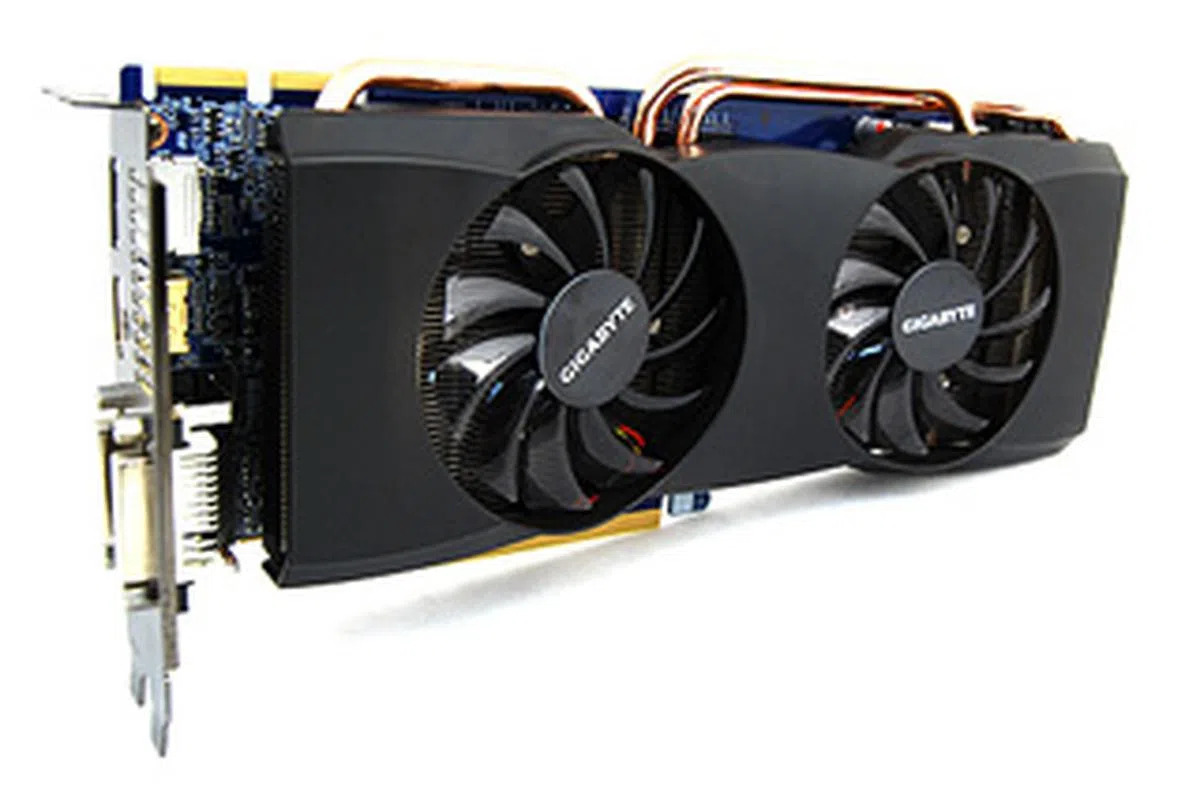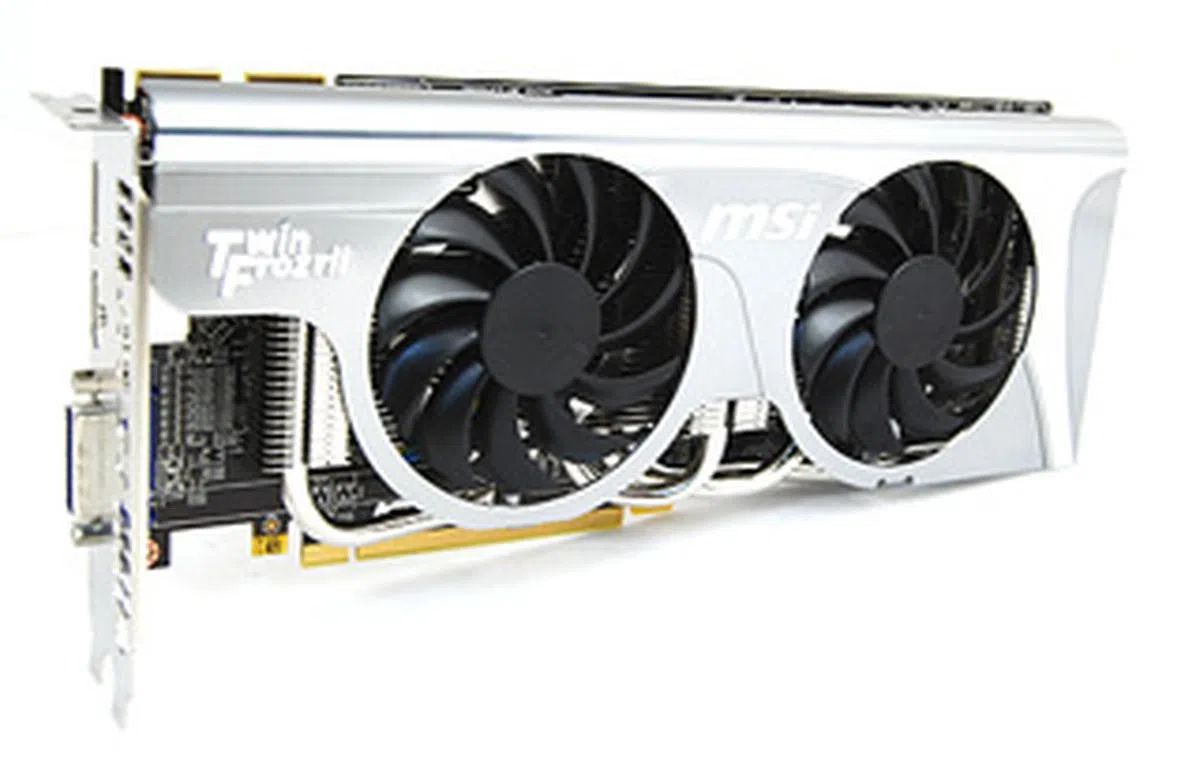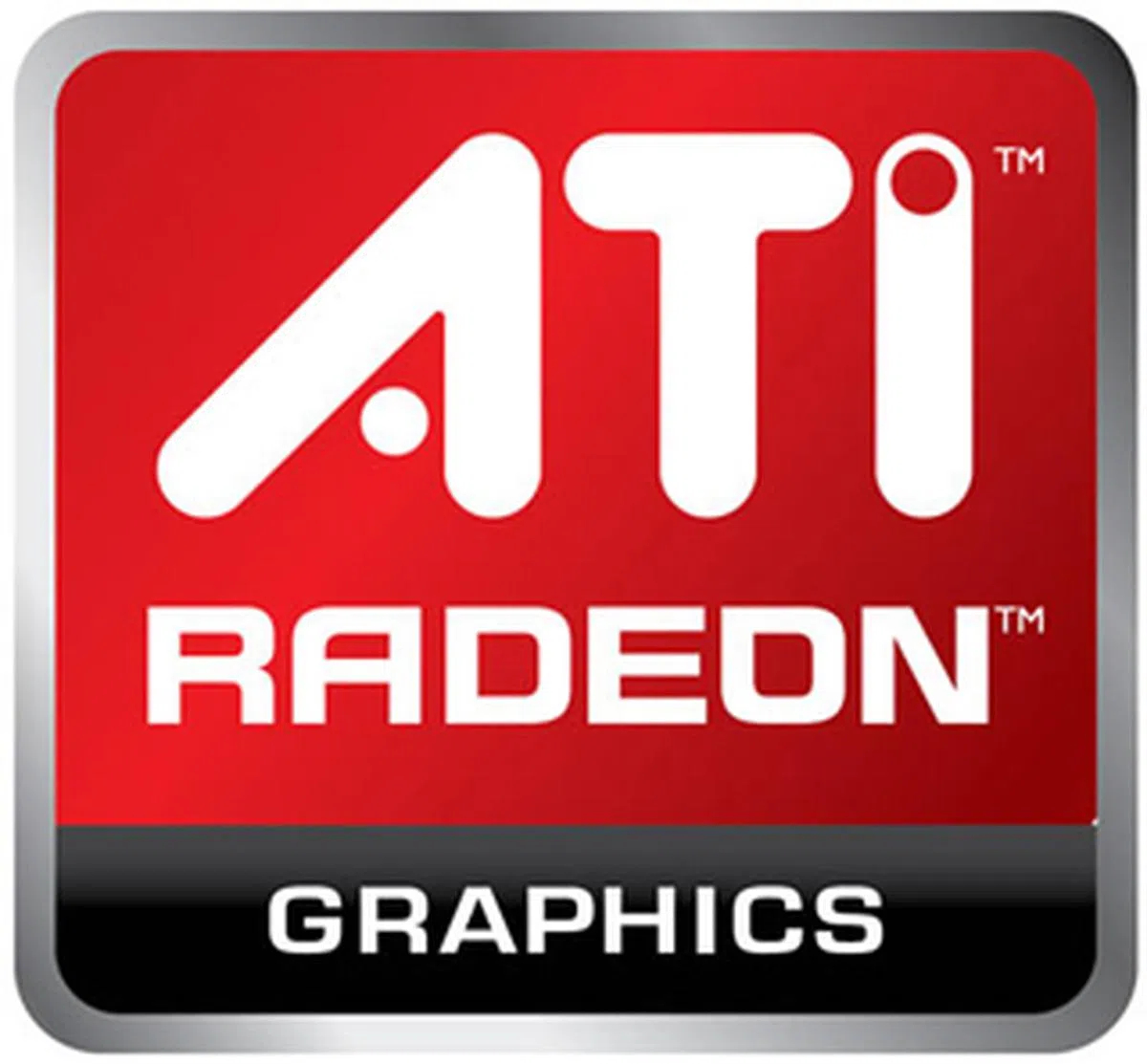ATI Radeon HD 5830 - Plugging The Performance Gap, Again
ATI recognizes that there's a substantial gulf between the Radeon HD 5850 and the HD 5770, and so it has come up with the Radeon HD 5830 in hopes of addressing that performance gap. We review three options from Gigabyte, HIS and MSI.
By Kenny Yeo -
Another Gap to Fill
Another gap to fill? Sounds like a familiar story. Back when ATI released their Radeon 4000 series, they had the awesome Radeon HD 4870 and HD 4850, both of which provided excellent performance for their price. A rung below the Radeon HD 4850 was the HD 4670 (the HD 4770 only came later), which meant there was a big gulf in performance for ATI to fill. Enter, then, the Radeon HD 4830, and subsequently, HD 4770.
This time round, ATI is suffering from the same problem they did with their previous generation graphics cards. While there's no doubting the tremendous graphics horsepower of the top tier Radeon 5800 series, the Radeon HD 5700 series, on the other hand, is a little underwhelming. In our tests, we found that the Radeon HD 5770 had problems keeping up with the older Radeon HD 4890, leading us to believe that it was the HD 5770's narrower 128-bit wide memory bus that was the culprit. Because of the Radeon HD 5770's performance, or lack thereof, it created a big price and performance gap between itself and the Radeon HD 5850.
So now to plug this price and performance gap, ATI has introduced yet another member to the Evergreen family, and it is the Radeon HD 5830.

We have thee Radeon HD 5830 cards in our labs and we shall be putting them through our tests to evaluate their performance.
Introduced in late February this year, the Radeon HD 5830 is closely related to both the Radeon HD 5870 and HD 5850, as it uses a stripped down version of the Cypress chip. Instead of the 1600 and 1440 stream processors found on the Radeon HD 5870 and HD 5850 respectively, the new Radeon HD 5830 instead has only 1120. And compared to the Radeon HD 5850, it also has lesser texture mapping units - 56 vs. 72.
However, it will continue to use ultra-fast GDDR5 memory and memory clock speeds will remain the same at 4000MHz DDR. And to make up for the reduction in stream processors, the Radeon HD 5830's core clock speeds will be bumped up to 800MHz - 75MHz higher than the Radeon HD 5850. Therefore, it'll be interesting to see how these changes will affect the Radeon HD 5830's performance.

Screenshot from GPU-Z detailing the technical specifications of the Radeon HD 5830.
Here's a quick look at how it measures up against its closest rivals.
Model | ATIRadeon HD 5830 1GBGDDR5 | ATI Radeon HD 5850 1GB GDDR5 | ATIRadeon HD5770 1GBGDDR5 | NVIDIAGeForce GTX 465 1GBGDDR5 | NVIDIAGeForce GTX 470 1GBGDDR5 | NVIDIAGeForce GTX 285 1GBGDDR3 |
Core Code | Cypress LE | Cypress Pro | Juniper XT | GF100 | GF100 | GT200 |
Transistor Count | 2150 million | 2150 million | 1040 million | 3200 million | 3200 million | 1400 million |
Manufacturing Process | 40nm | 40nm | 40nm | 40nm | 40nm | 55nm |
Core Clock | 800MHz | 725MHz | 800MHz | 607MHz | 607MHz | 648MHz |
Stream Processors | 1120 Stream Processing Units | 1440 Stream processing units | 800 Stream Processing Units | 352 Stream Processors | 448 Stream Processors | 240 Stream Processors |
Stream Processor Clock | 800MHz | 725MHz | 800MHz | 1215MHz | 1215MHz | 1476MHz |
Texture Mapping Units (TMU) or Texture Filtering (TF) units | 56 | 72 | 40 | 44 | 56 | 80 |
Raster Operator units (ROP) | 16 | 32 | 16 | 32 | 40 | 32 |
Memory Clock | 4000MHz GDDR5 | 4000MHz GDDR5 | 4800MHz GDDR5 | 3206MHz GDDR5 | 3348MHz GDDR5 | 2484MHz GDDR3 |
DDR Memory Bus | 256-bit | 256-bit | 128-bit | 256-bit | 320-bit | 512-bit |
Memory Bandwidth | 128GB/s | 128GB/s | 76.8GB/s | 102.6GB/s | 133.9GB/s | 159.0GB/s |
PCI Express Interface | PCIe ver 2.0 x16 | PCIe ver 2.0 x16 | PCIe ver 2.0 x16 | PCIe ver 2.0 x16 | PCIe ver 2.0 x16 | PCIe ver 2.0 x16 |
Molex Power Connectors | 2 x 6-pin | 2 x 6-pin | 1 x 6-pin | 2 x 6-pin | 2 x 6-pin | 2 x 6-pin |
Multi GPU Technology | CrossFireX | CrossFireX | CrossFireX | SLI | SLI | SLI |
DVI Output Support | 2 x Dual-Link | 2 x Dual-Link | 2 x Dual-Link | 2 xDual-Link | 2 x Dual-Link | 2 x Dual-Link |
HDCP Output Support | Yes | Yes | Yes | Yes | Yes | Yes |
Street Price | ~US$220 | ~US$300 | ~US$160 | ~US$279 | ~US$349 | ~US$350 |
The Gigabyte HD 5830
The Gigabyte HD 5830 might be running on reference clock speeds - 800MHz at the core and 4000MHz DDR at the memory – but it tries to be different by utilizing Gigabyte's specially-designed dual-fan cooler. Coolers with twin fans are not uncommon these days, but what makes Gigabyte's so special is that its fans are inclined at an angle. Gigabyte claims this reduces air turbulence allowing greater airflow and therefore enhanced cooling.

The Gigabyte HD 5830 comes with the dual fan cooler that we've become familiar with, seeing that it has been offered on their high-end cards.

Like most Evergreen cards, the Gigabyte HD 5830 comes with the usual twin DVI ports and single HDMI and DisplayPort.

A closer look at the fan. As you can see it is inclined at an angle towards the heatsink below.
The HIS HD 5830 iCooler V Turbo
As the Turbo suffix suggests, the HIS HD 5830 iCooler V Turbo comes factory overclocked at 840MHz at the core and 4400MHz DDR at the core. The card also features HIS' iCooler custom cooler, which again, as its name suggests, is in its fifth generation. According to HIS, the new iCooler promises not only better cooling efficiency but also lower noise operating levels.

The iCooler cooler is already into its fifth edition and fans of Modern Warfare 2 will definitely appreciate the looks of this card.

No surprises on the HIS card as it too gets two DVI ports and the a single HDMI and DisplayPort.

Taking a closer peek, we can see the dense cooling fins of the heatsink.
The MSI R5830 Twin Frozr II
MSI's celebrated Twin Frozr II custom cooler makes another appearance, this time on the MSI R5830 Twin Frozr II. We have had great experiences with the Twin Frozr II cooler, so we are expecting this card from MSI to run really cool. That aside, the card also comes with MSI's usual suite of “Military-Class Components”, which includes solid state chokes and Hi-C Caps for better voltage control, overclocking and efficiency. So it's a pity to find that despite all the features the card is packing, MSI has unfortunately decided to go with reference clock speeds for this card.

The MSI card uses the distinctive Twin Frozr II cooler, which comes in its standard silver/chrome finishing.

The oddball of the lot, the MSI R5830 Twin Frozr II sacrifices a DVI port and instead provides a single DVI, HDMI and DisplayPort.

Massive heat pipes are the order of the day, as the MSI card has no less than four heat pipes to quicky draw heat away from the GPU core.
Test Setup
The cards will be tested using our high-end X58 system with the following specifications:
- Intel Core i7-975 (3.33GHz)
- Gigabyte GA-EX58-UD4P motherboard
- 3 x 1GB DDR3-1333 OCZ memory in triple channel mode
- Seagate 7200.10 200GB SATA hard drive
- Windows 7 Ultimate
With the HIS HD 5830 iCooler V Turbo sporting higher clock speeds, we are expecting it to come out tops against the Gigabyte HD 5830 and MSI R5830 Twin Frozr II, both of which are running on reference clock speeds.
But what's of more interest to us is how the Radeon HD 5830 performs in comparison to the Radeon HD 5850 and HD 5770; and of course against its rivals from the green camp, namely the recently anounced GeForce GTX 465.
The full list of tested cards and their driver versions:
- Gigabyte HD 5830 (Catalyst 10.5)
- HIS HD 5830 iCooler V Turbo (Catalyst 10.5)
- MSI R5830 Twin Frozr II (Catalyst 10.5)
- ATI Radeon HD 5850 (Catalyst 10.6)
- ATI Radeon HD 5770 (Catalyst 10.5)
- NVIDIA GeForce GTX 465 (ForceWare 257.21)
- NVIDIA GeForce GTX 470 (ForceWare 197.41)
- NVIDIA GeForce GTX 285 (ForceWare 196.24)
The list of benchmark used are as follows:
- Futuremark 3DMark Vantage
- Crysis Warhead
- Far Cry 2
- Warhammer: Dawn of War 2
- Battlefield Bad Company 2
- “Heaven" from Unigine v1.0
- S.T.A.L.K.E.R.: Call of Pripyat
3DMark Vantage Results
Here, we can see the Gigabyte and MSI cards racking up nearly identical scores, which is as we've anticipated, considering both are running on reference clock speeds. The HIS card scored higher thanks to being factory overclocked.
Looking at the Radeon HD 5830 as a whole, its scores are right smack in the middle between the Radeon HD 5850 and HD 5770. It was competitive against its rival from the green camp too, handily outscoring the GeForce GTX 465.

Crysis Warhead Results
On Crysis Warhead, we noticed the HIS card taking a lead against the Gigabyte and MSI cards, which is not surprising seeing that it is factory overclocked. We also noticed that the performance of the Radeon HD 5830 is, once again, in the middle between the Radeon HD 5850 and HD 5770. It was also able to keep up with the GeForce GTX 465, but showed signs of slowing down when we enabled anti-aliasing.


Far Cry 2 Results
Far Cry 2 is a game that has traditionally been dominated by the NVIDIA cards, and it was the same here. The GeForce GTX 470 is by far the fastest card, and even the less powerful GeForce GTX 465 could give the Radeon HD 5850 a run for its money.
The Radeon HD 5830 continues to perform in between the Radeon HD 5850 and HD 5770, but we noticed that its performance dipped quite a bit when 8x anti-aliasing was enabled. With 8x anti-aliasing enabled, its performance was only about on a par with the Radeon HD 5770. The cut in the number of ROP units seem to be the cause for this.


Dawn of War 2 and Battlefield Bad Company 2 Results
Our trio of Radeon HD 5830 cards started brightly on Dawn of War 2, coming close to the performance of the more powerful and costly Radeon HD 5850. However, its performance dipped significantly as we increased the resolution. At 1280 x 800, it was only about 5% slower, but at 1920 x 1200, the difference increased to almost 20%. However, it was able to keep pace with the GeForce GTX 465.

On Bad Company 2, the factory overclocked HIS card once again found itself outperforming the reference clocked Gigabyte and MSI cards. And on a whole, the Radeon HD 5830 found itself sandwiched between the Radeon HD 5850 and HD 5770, which has been the case thus far. However, performance on Bad Company 2 leans more towards the less powerful Radeon HD 5770. And while the Radeon HD 5830 was able to keep up with the GeForce GTX 465 on Dawn of War 2, it was unable to do so here.

Unigine "Heaven" Results
As we've anticipated, the HIS card continued to outperform the other two reference clocked cards from Gigabyte and MSI. Its lead, however, was very slight. And overall, the Radeon HD 5830's performance was between that of the Radeon HD 5850 and HD 5770. Against its closest competitor from the green camp, the GeForce GTX 465, the Radeon HD 5830 was mostly slower, but was able to catch up once we upped the resolution.
DirectX 11 Results


DirectX 10 Results


S.T.A.L.K.E.R.: Call of Pripyat Results
On our last benchmark, the HIS card continued to maintain its slight lead over the reference clocked Gigabyte and MSI cards. And in general, the Radeon HD 5830 did as it was expected to, coming in between the Radeon HD 5850 and HD 5770. Against the GeForce GTX 465, it wasn't as competitive, being thoroughly outclassed on most of the runs and settings. The only time it caught up with the GeForce GTX 465 was when running the SunShafts run in DirectX 10.
DirectX 11 Results
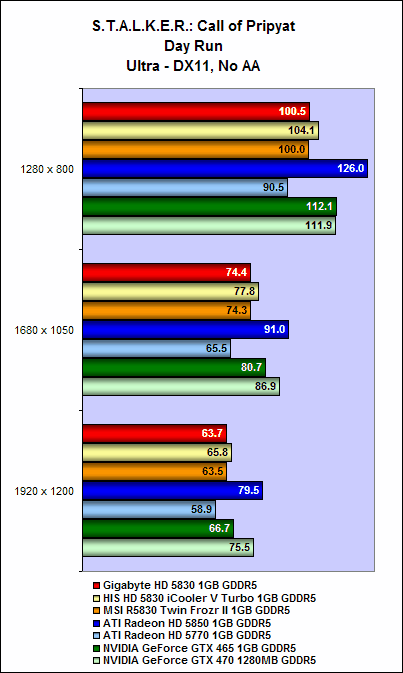 | 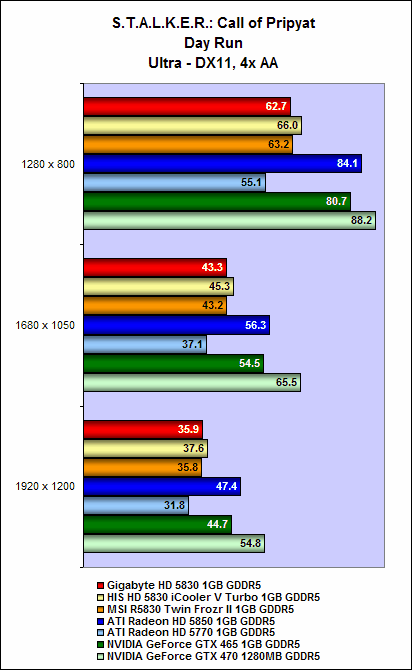 |
 | 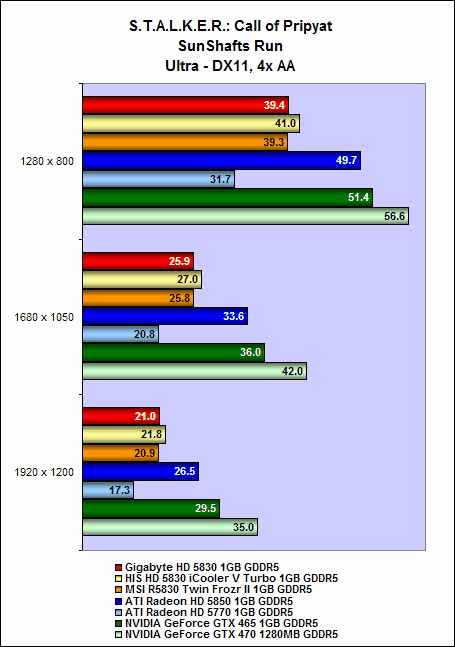 |
DirectX 10 Results
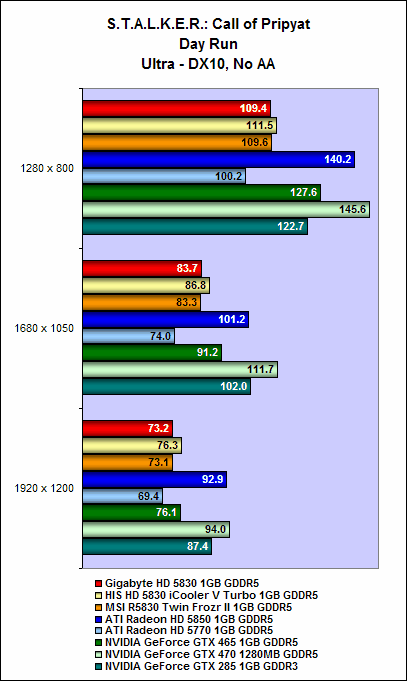 | 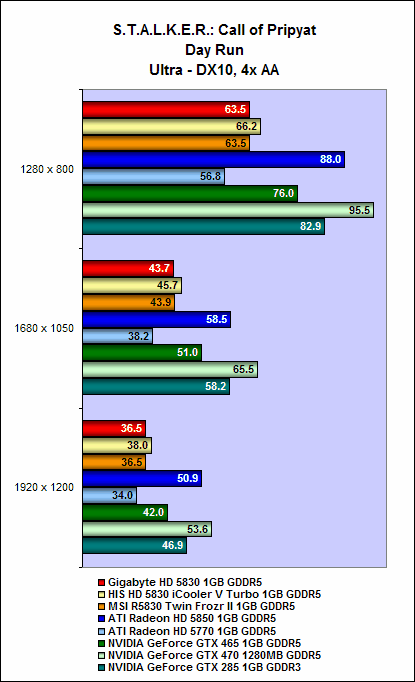 |
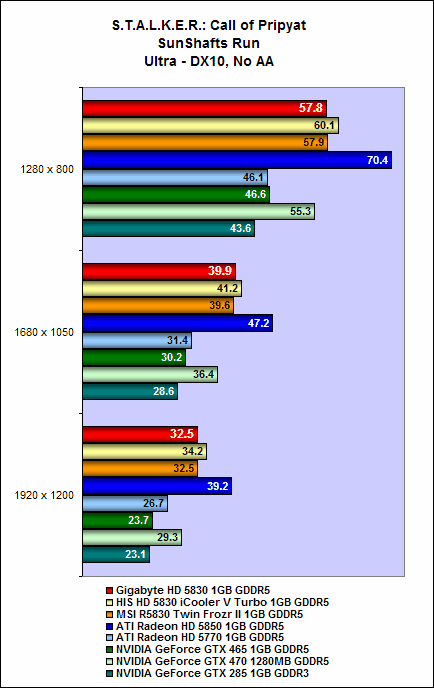 | 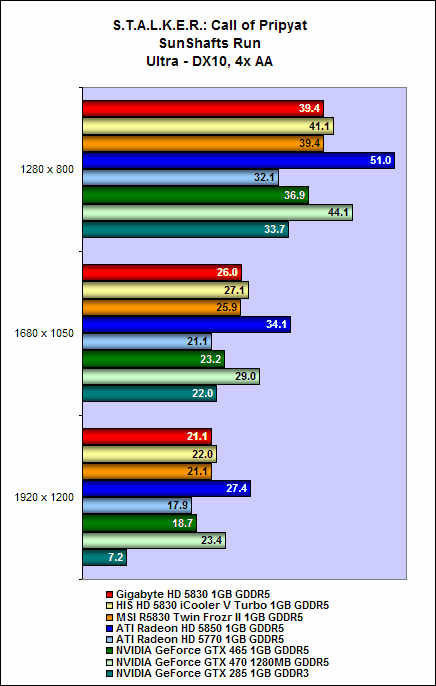 |
Temperature
Our trio of Radeon HD 5830 cards all came with customized cooling solutions, so it was interesting to see which was most effective. The Gigabyte HD 5830 and MSI R5830 Twin Frozr II did the best in our temperature test, as both managed around 55 degrees Celsius. Since there's no reference version of the Radeon HD 5830 from ATI to act as a baseline, it's difficult to say how effective the coolers are. Nevertheless, 55 degrees Celsius is an ideal reading in our books. The HIS HD 5830 iCooler V Turbo recorded 64 degrees Celsius, which is substantially more than its competitors, but was somewhat expected due to its overclocked nature and its single fan design.

Power Consumption
Despite the hardware reduction, the power consumption figures we recorded from our triplet of Radeon HD 5830 cards were comparable to that of the Radeon HD 5850. We suspect this is due to the Radeon HD 5830's higher reference clock speeds. If you recall, a reference Radeon HD 5830 is running at 800MHz at the core, whereas the Radeon HD 5850 is only running at 725MHz. Add to that is the same GPU core used on the 5850 and 5830 models, the results are quite apparent. That said, all three Radeon HD 5830 cards recorded roughly the same figures.

Overclocking
What impressed us about the Radeon HD 5830 was its overclocking abilities. With a stock clock of 800MHz at the core, it was amazing that all three cards managed to go well beyond 900MHz. The HIS HD 5830 iCooler V Turbo was our top performer here, managing as astonishing 980MHz at the core and 52000MHz DDR at the memory. This allowed it to score 7569 3DMarks on the Extreme preset, which surpasses even the Radeon HD 5850.
As for the other two Radeon HD 5830 cards, we are pleased to say that the MSI R5830 Twin Frozr II did well too, managing 970MHz at the core and 4900MHz DDR at the memory with some tweaking using its bundled Afterburner overclocking utility. And finally, the Gigabyte HD 5830, though last in our roundup, managed a commendable 940MHz at the core and 4600MHz DDR for the memory.

A Decent Addition to the Family
By and large, the ATI has delivered with the Radeon HD 5830 and has done a decent job of filling the huge performance and price gap that has been left by the Radeon HD 5850 and HD 5770.
On the performance front, the Radeon HD 5830 finds itself smack in between the Radeon HD 5850 and HD 5770. Although it must be said that it has a tendency to lean towards the Radeon HD 5770 rather than the HD 5850, especially on higher resolution settings or when we enabled anti-aliasing.
However, it makes up for this shortcoming somewhat with its impressive overclocking performance. Although we cannot guarantee stability and reliability of the cards should they be running at the maximum clock speeds we've achieved, it's safe to say that a slight overclock of around 50 to 70MHz should be manageable, considering these cards all managed to easily hit 100MHz above their default core clock speeds.
With a retail price of around US$220, the Radeon HD 5830 also finds itself priced directly between the Radeon HD 5850 and HD 5770. So it's not really an attractive option, rather, it is a sensible addition to the Evergreen stable, since it offers a legitimate solution for users who can't justify paying the premium for the Radeon HD 5850 and yet is looking for something more than the Radeon HD 5770.
NVIDIA has nothing new at the US$220 price point, but we can't help but notice that the cheaper Radeon HD 5830 was, at times, able to give the more costly GeForce GTX 465 (US$279) a run for its money.

The new Radeon HD 5830 provides decent performance for its price, and does the job of filling the gap between the Radeon HD 5850 and HD 5770 well.
Locally, the Radeon HD 5830 is not as attractively priced seeing that it costs around S$380. The Radeon HD 5850 comes in at around S$430 and the less powerful Radeon HD 5770 is much more affordable at S$270. If you remember that the Radeon HD 5830's performance leans more towards the Radeon HD 5770, then S$380 is asking too much. So for local readers, it's better to stick either with the Radeon HD 5770, or stretch that little bit more and go for the Radeon HD 5850.
Overall, the Radeon HD 5830 is a decent new SKU by ATI and it serves its purpose of addressing the price and performance gap between the Radeon HD 5850 and HD 5770 well.
As for the individual cards, here's a quick summary of their clock speeds and price.
Card | Core clock speed | Memory clock speed | Price |
Gigabyte HD5830 | 800MHz | 4000MHz DDR | US$219 |
HISHD 5830 iCooler VTurbo | 840MHz | 4400MHz DDR | US$250 |
MSI R5830 Twin Frozr II | 800MHz | 4000MHz DDR | US$255 |
The HIS HD 5830 iCooler Turbo is our pick of the lot. Not only was it the fastest, it also provided the best overclocking potential, despite not having the high-end features that the MSI R5830 Twin Frozr II has. Furthermore at US$250, it also costs a tad less than the MSI card, which, all things considered, makes it quite good value for money. What's more, it comes with a redeemable copy of the hit game, Modern Warfare 2.
That said, the MSI R5830 Twin Frozr II, we feel is a bit on the pricey side. Coming with reference clock speeds was a bit of a disappointment, but what's even more disappointing is that even its overclocking ability was trumped by the HIS card. Of course, there's an element of luck involved where overclocking is concerned, but the fact is that the HIS costs less and delivers more.
Lastly, the Gigabyte HD 5830 is the most affordable card here and provided decent all round performance, so we have no complaints.
<img height="203" width="320" src="https://cassette.sphdigital.com.sg/image/hardwarezone/93a73945e489cc48a55d62d96747c04130f3b91978ba745d8539c00b8c6b879a" title="The HIS HD 5830 iCooler V Turbo " class="caption" alt=""> |
|
|  |
|  |
|  |
Our articles may contain affiliate links. If you buy through these links, we may earn a small commission.

